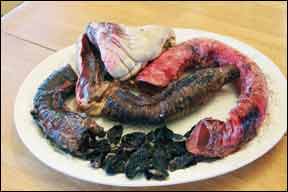Making meals from scratch is the only way I know to have exactly what I want for my dogs – no ingredients from places with spotty records for quality assurance, no multi-syllabic additives making a label longer than I like. After I covered the pet-food recall in 2007, I changed the way I eat and the way I feed my pets. For my dogs, that meant commercial products from companies I trusted, along with raw-food meals from regional sources of meat, grains, and vegetables.

It wasn’t a huge shift from raw to cooked when my Flat-Coated Retriever, McKenzie, started chemotherapy for soft-tissue sarcoma a few days after her seventh birthday. At the suggestion of her veterinary oncologist, I dropped the carbs, rebalanced the diet with the help of some expert advice, and started feeding “McKenzie Meatloaf” to all three of my dogs. The canine “cancer diet” is essentially carb-free, and cooked to reduce the load of potential pathogens that trouble many veterinarians about diets with raw meat, especially when a dog’s immune system is suppressed by medication.
While it was easy to turn a good raw diet into a good cooked one, I ran into a challenge when it came to treats. The solution? A dehydrator. Allow me to share what I’ve learned about making healthy and irresistible dog treats.
1. If you’re serious, buy a big dehydrator.
Dehydrators come in all sizes and price ranges; I went with a fairly large home model from Excalibur. I’ve been very happy with it, although if I were to do it again, I’d spring for the model with a timer, adding $25 to the cost.
Dehydrators start about $30, and the large one I bought was $250 retail, but I paid $200 online. Check eBay or Craigslist and you can get an even better deal if you are patient; I’m generally not!
For cubed or stripped meats/organs, my nine-tray model will easily dehydrate 20 pounds of meat at once. Because some parts are large (beef hearts are 10 pounds, and livers are large, too) and because I buy even small items in bulk (such as turkey, chicken, or duck hearts packaged in 10-pound bags) I got a large dehydrator so I can process a lot at once.
2. Find quality meats.
Join a raw food buyer’s group or co-op if one is anywhere near you; then you should be able to get meat from humanely cared-for, local animals at a good price. I buy bulk bags of hearts (chicken, turkey, and beef), liver (chicken and beef), and beef trachea from a raw feeders’ co-op about 100 miles from where I live. Other parts are on order, including poultry feet and what are euphemistically called “pizzles” – cattle penis. Even if you don’t have access to a buyer’s group, a custom butcher should be able to hook you up with products you’ll never see in your supermarket.
The biggest surprise? Beef trachea. Raw cattle windpipes – they can be two or more feet in length with a diameter of 3 to 4 inches – are a little hard to handle if you’re squeamish. Tracheas are awkwardly shaped, and require the removal of every other tray in my dehydrator to accommodate their height, so I can dry only five of these at a time. But after eight hours in the dehydrator they dry into perfect chews that are easily cut with a bread knife into two pieces that are just right for chewing by my retrievers.
3. Read the cleaning and safety instructions.
You’re ready to go after reading the booklet that comes with the machine. Precise drying isn’t a problem, since dogs are pretty happy even if you overshoot the “chewy” stage of jerky preferred by humans.
4. Set it up somewhere . . . else.
I don’t dehydrate in the kitchen; the smell of liver drying at low heat was gag-inducing for me – and hard to ignore for my drooling dogs. After the first batch was done, the dehydrator found a permanent set-up in the garage.
5. Prepare the meat.
This is easy. I rinse the meat, cut it to double the size I want to end with, put it on the racks, and turn on the machine for a few hours. That’s it! When it’s reached the level of dryness I want, I store the treats in plastic bags or containers in the freezer, taking out a little at a time for freshness.
So what do my dogs think? They love the treats. The poultry hearts and liver are good for training, and the trachea sections are every bit as popular as store-bought chews.
No matter what the future brings for McKenzie, I suspect I’ll be using the dehydrator to make treats for my dogs for years to come. It’s only been a few months since I bought it, but the dehydrator is nearly paid for in what I’ve saved by not buying organic, top-quality treats.
A resident of Northern California, Gina Spadafori is a syndicated pet-care columnist and the author of more than dozen books on animals and their care. She is also the writing partner of “Good Morning America” veterinarian Dr. Marty Becker.





